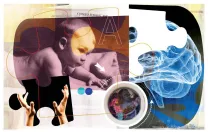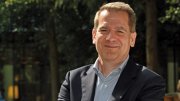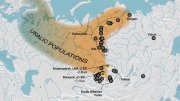During the past few decades, most scientific research into the causes of autism has been focused on the structural wiring of the brain and on the genes that control it. Evidence of chronic sickness or general physical discomfort in autistic children has largely been viewed as coincidental to the primary brain disorder or, in some instances, mistaken for the syndrome’s behavioral symptoms. But in recent years, as the number of cases has continued to rise (while the genetic pathways have remained elusive), several clinicians and researchers have begun to ask whether disturbances in children’s broader bodily systems may be influencing, or even causing, the disruption in their brains.
Associate professor of neurology and pediatric clinician Margaret Bauman has been on a crusade to ensure that children with autism-spectrum disorders receive adequate medical care. As the director of LADDERS (Learning and Developmental Disabilities Evaluation and Rehabilitation Services)—a multidisciplinary research clinic affiliated with Massachusetts General Hospital (MGH)—she spearheaded a new model for diagnosing and treating the host of physiological problems that often accompany autistic disorders. The LADDERS staff includes experts in gastroenterology, sleep disorders, and neuromuscular and metabolic disorders, as well as in psychopharmacology, neurology, and developmental pediatrics. (In 2005, Bauman cofounded the Autism Treatment Network, a national nonprofit organization of six clinical programs around the country that collaborate to promote current best practices in the diagnosis and treatment of autism-spectrum disorders.)
“Many kids with autism have gastrointestinal problems that may affect their behavior,” Bauman explains. “But because these kids are often nonverbal or hypoverbal, they have trouble conveying their discomfort or localizing their pain.” Children with intense gastritis or colitis may bang their heads or move their bodies in strange ways in reaction to physical distress. “It turns out that when you treat the medical problem, in many cases the aggressive and self-injurious behaviors abate,” she says. Bauman has also found that a subset of children on the spectrum who do not respond to standard autism therapies have a disorder involving their mitochondria (the cellular structures that convert nutrients into energy). These kids tend to walk late, have very little energy, and undergo periodic regressions in which they lose muscle control, attentiveness, and language. Bauman was surprised to find that a complex vitamin treatment helped improve the condition of a number of such children, enabling them to benefit from behavioral therapies.
Bauman does not suggest that such biomedical interventions will cure autism, but she believes that researchers need to pay close attention to the pattern of physiological problems that attend the autistic syndromes of a significant portion of children. “We haven’t been looking at other organ systems and how they relate to this disorder,” she says. “It’s possible that we’ve been doing genotyping on apples and oranges.”
Assistant professor of neurology Martha Herbert, a pediatric neurologist at MGH, couldn’t agree more. Herbert has been at the forefront of an effort to alter the prevailing paradigm of autism research. As a resident in neurology in the early 1990s, she spent two years studying the preserved brain samples of 93 autistic individuals, hoping to find a correlation between specific structural abnormalities and autistic behaviors. What she found instead, she explains, were “abnormally large brains with more than average white matter [the tissue through which messages pass between different areas of gray matter in the brain, where the nerve cell bodies are located]. I began to think that this is not a localized brain disorder but a generalized disorder that affects the brain. It requires a different way of thinking.”
Herbert found evidence that a subgroup of children with autism experience a sudden increase in brain size a year or so after birth. The areas that enlarge are those where the myelin sheath—the fatty electrical insulator of the brain cells—forms post- rather than prenatally. The question of whether some children are born “normal” and then “regress” into autism between the ages of one and two has been at the center of the controversy over the potential role of mercury and vaccines in causing autism. Although Herbert steers clear of this debate, her findings suggest that postnatal damage may contribute to the onset of autistic conditions in a considerable number of cases.
Herbert believes that such tissue changes in autistic brains could be signs of inflammation or oxidative stress, potentially implicating environmental factors. (Oxidative stress refers to an imbalance between the rate of oxidative damage to cells and the rate of cell repair.) “Perhaps the brain is caught ‘in the crossfire’ of whole-body changes related to environmental stress,” she says. She has not proposed any particular toxin exposure as a cause of autism; rather she underscores the need to expand the investigative lens beyond the genes-brain-behavior model in order to look for broader problems in physiological functioning. “We need more study of environmentally responsive metabolic and signaling pathways,” she explains, “since these will guide us both to where to look for relevant genes and also where to look for treatment targets.”
Herbert’s ideas are not universally accepted by neurogeneticists; but among many in the mainstream of autism research there is growing support for a more biological approach to diagnosis. Susan Santangelo, associate professor of psychiatry at Harvard Medical School and an associate professor in epidemiology at Harvard School of Public Health, who also serves as director of statistical genetics and genetic epidemiology in the psychiatric and neurodevelopmental genetics unit at MGH, argues that researchers need to begin to look for more precise measures to identify and sort individuals with autism disorders.
Santangelo, an executive committee member of the Boston Autism Consortium (which links more than 50 local researchers who tackle different aspects of the disease cycle and share results), suggests that tests such as an EEG (electroencephalogram, which measures electrical activity in the brain), an ERP (event-related potential, which records brain activity during specific tasks), or a measure of blood plasma levels for certain metabolites could provide investigators with markers that they could correlate to a given set of behavioral traits, thus helping to distinguish patients’ functions on a variety of levels. “If we can start to map the genes for something more biological,” Santangelo explains, “something closer to the genetic action, then maybe we’ll have more success than [we’ve had] trying to map the genes for a very heterogeneous psychiatric classification that may bear absolutely no relation to underlying pathophysiology. We need to cast a wide net and then tunnel deep into some of these measures.”









